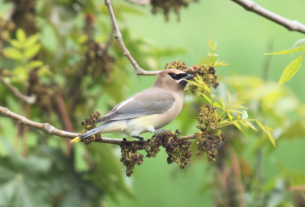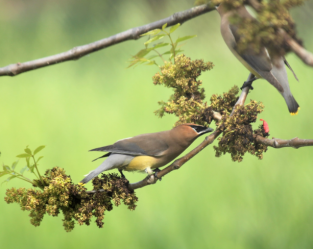
By Greg Dunne
March 12, 2019 (San Diego’s East County) – It’s seems that it has been hard to find a sunny day for a walk or hike lately here in San Diego County. However, I did get out for a walk at Santee Lakes a few days ago without getting rained on. I had a very rare bird sighting here in our East County, the Cedar Waxwing.
The Cedar Waxwing is the “Batman Bird” for me as you can see by the black mask around their eyes. It was exciting for me to get a few photos of them because I have only seen these birds a few times. They are visitors here during the winter and early spring but reside mostly in Canada and the very Northern part of the United States.
 Spotting this group at Santee Lakes last week was a thrill as I was there watching them for at least 15 minutes – although by bouncing around the trees they were not particularly helpful in allowing me to photograph them. Several people were passing me by, but no one seemed interested. I did happen to see another birder much later in my walk and shared with him my photos. He was very envious, as all he had to show for his day was a couple of Cormorants and some ducks.
Spotting this group at Santee Lakes last week was a thrill as I was there watching them for at least 15 minutes – although by bouncing around the trees they were not particularly helpful in allowing me to photograph them. Several people were passing me by, but no one seemed interested. I did happen to see another birder much later in my walk and shared with him my photos. He was very envious, as all he had to show for his day was a couple of Cormorants and some ducks. They are a fruity bird. I say that because everything about them focuses on the fruit that they love. They usually fly in large groups and are very active eaters, mainly fruits and berries, and they can become intoxicated when their eating becomes over indulgent. This group at the lake were feeding quite a bit in the trees, but none of them seemed to be “over the limit”. They’ve been known to pass fruit from one bird to another, in a fun sort of manner.
 The Cedar Waxwing is believed to have acquired its name from its fascination for cedar fruits, as well as for the unusual red, waxy deposits at the tips of the secondary feathers. Some individual waxwings will have an orange tipped tail (in place of yellow), which is said to be caused due to the consumption of an introduced species of berries called the Morrow’s Honeysuckle.
The Cedar Waxwing is believed to have acquired its name from its fascination for cedar fruits, as well as for the unusual red, waxy deposits at the tips of the secondary feathers. Some individual waxwings will have an orange tipped tail (in place of yellow), which is said to be caused due to the consumption of an introduced species of berries called the Morrow’s Honeysuckle.Cedar Waxwings breed much later in the year than other songbirds, to coincide with the availability of summer-ripening fruits. When courting, the male waxwing performs a hopping dance for the female; if she's interested, she will dance with him, and the pair hops back and forth together. Courting waxwings will also sit together and pass small objects back and forth, such as flower petals, a berry, or an insect, in a demonstration of their devotion.
 This is a fun and attractive bird--the Fruity Batman Bird, as I’ve nicknamed the species. As the winter is colder and longer this season up north, these birds may be visiting for a bit longer this year. We may get to see them through April.
This is a fun and attractive bird--the Fruity Batman Bird, as I’ve nicknamed the species. As the winter is colder and longer this season up north, these birds may be visiting for a bit longer this year. We may get to see them through April. 






Recent comments